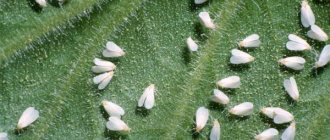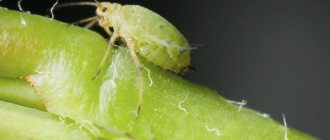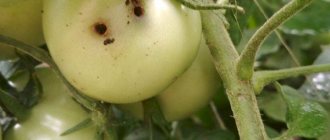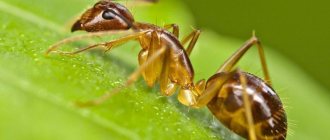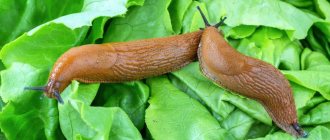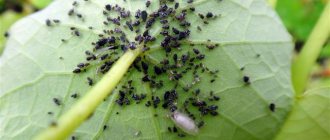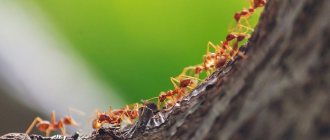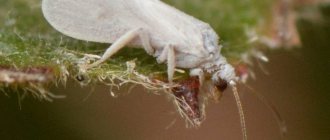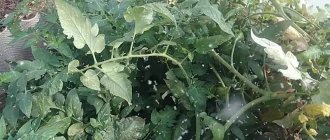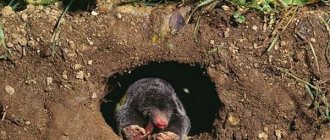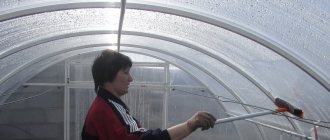Many gardeners who strive to obtain early and long-lasting vegetable harvests are forced to face the problem of how to get rid of whiteflies in a greenhouse on cucumbers and tomatoes. These tiny but numerous insect pests, sucking the juices out of plants and depriving them of vitality, are capable of causing enormous damage and nullifying all human efforts.
Whitefly (pictured) is one of the most common pests of greenhouse crops and indoor plants
There is only one way out of this situation - to comprehensively apply all possible control methods, taking into account the biological characteristics of this insect.
What is whitefly
Trialeurodes vaporariorum or the greenhouse whitefly is a flying insect that belongs to the genus Ileuroids. Externally, this pest looks like a small moth with a small yellow body (up to 1.5 mm in length) and four small white wings, covered with a powdery coating, which fold into one plane.
An adult female lives no more than a month, during which she is able to lay up to 130 eggs with an average size of 0.25 mm. The whitefly lays clutches on the reverse side of leaf blades, arranging them in concentric circles. Each of these circles can have up to 30 eggs. Initially their color is greenish with a yellow tint, gradually they darken and eventually become almost black.
The hatched larvae are flat, oval in shape, and light green in color. They go through 4 phases of development, growing during this time from 0.9 to 0.9 mm. In the first phase, the larvae are unusually mobile and voracious; they quickly move from leaf to leaf, from plant to plant, actively sucking cell sap from the leaf plates. During this period, they need abundant nutrition, after which a sticky secretion remains on the foliage - a product of their vital activity.
After entering the second phase, the larvae become motionless, but also eat a lot. In total, the first three phases of the larvae pass in about 2 weeks.
In phase 4, whitefly larvae are covered with a special waxy coating and become invulnerable to even the most powerful insecticides. This phase lasts up to 2 weeks, then adult flying individuals emerge from the larvae.
If greenhouses are heated in winter, then the whiteflies living in them can produce 4 generations over the entire calendar year. Favorable conditions for their reproduction: temperature around +22+26०С and humidity 61-75%.
Important! In the climatic conditions of the middle zone and other regions with similar winters, the whitefly cannot overwinter in the ground, but can wait out the cold in greenhouses or on indoor flowers.
Features of the whitefly life cycle
whitefly belongs to the suborder Aleurodidea of homoptera, similar to microscopic butterflies, proboscis insects - pests of vegetable and ornamental crops, found everywhere in greenhouses, hotbeds and greenhouses. The Latin name comes from the word aleuron - “flour”, since the wings of these “moths” (close relatives of psyllids) are covered with a white coating of powdery pollen. The generally accepted nickname “whiteflies” also reflects the peculiarities of appearance: the presence of two pairs of white wings on a pale yellow body 1-1.5 mm long.
Whitefly larvae (pictured) are sometimes confused with another scourge - aphids
In greenhouse conditions, the lifespan of adults on tomatoes is 14 days, and on cucumbers - 19. Up to 15 generations of the pest can develop in a year, because the biological cycle is 24-40 days.
Over the course of their life (about 30 days), females manage to lay 85-130 eggs on the underside of leaves, in clutches of 10-20 pieces, randomly located or in the form of rings. After literally a few hours, the larva (creeper) emerges from the egg, attaches to the leaf and actively feeds on the plant juices for 10-14 days. Then it is fixed in a stationary state, covered with a waxy substance. After 13-15 days, an adult, voracious individual hatches from it and flies out. In greenhouse conditions they can live year-round, preferring moist and shaded places, and in the spring and summer months the number of pests increases significantly.
Why is whitefly dangerous for tomatoes?
These insects actively feed on the cell sap of any vegetable plants, including tomatoes, thereby causing enormous damage to these crops. In addition, they leave behind a sweet waste product - honeydew, which attracts many other harmful insects.
Following this small butterfly, ants can settle on tomatoes. And the indispensable companion of whiteflies is a sooty fungus, which also causes enormous harm to cultivated plants.
The main ways whiteflies can harm you are as follows:
- this pest and its larvae suck out too much cell sap from plants, which negatively affects the condition of garden crops;
- as a result, the foliage quickly turns yellow, dries and falls off ahead of schedule;
- whiteflies can cause ants to settle on tomatoes;
- The sweet secretions of whiteflies are the main reason for the appearance of sooty fungus on plants, which covers the leaf blades with a black coating that clogs the stomata. As a result, sunlight does not reach the leaves, photosynthesis stops in the vegetative mass, which makes it impossible to process incoming nutrients;
- fruits slow down ripening, white veins appear in their pulp, which impair the taste and appearance of ripe tomatoes;
- whiteflies often carry viral diseases for which there is no treatment, so affected vegetable crops have to be removed and destroyed;
- Cultivated plants affected by whitefly slow down their growth and development, sometimes they simply stop developing, and in the worst case, they die.
Important! If a whitefly settles on seedlings, they most often die because they do not have enough strength to resist the pest. Seedlings are also vulnerable during the period of acclimatization in a new place immediately after transplantation.
Signs of the presence of whiteflies on tomatoes
Getting on the leaves of tomatoes, the whitefly can not only spoil them, but also lead to the complete death of the fruit. Insects hide under the lower leaves of vegetables, where they lay eggs. They feed on the juice and water contained in tomato leaves.
When the temperature is favorable, the whitefly will increase in number exponentially. After which it will be much more difficult to remove it.
Whitefly on tomatoes
Important! The whitefly not only draws out all the juices from the plant, but also contributes to the spread of fungi, as a result of which the tomatoes begin to turn black.
Among the signs of plant damage by moths, it is worth highlighting:
- leaves begin to curl and turn yellow;
- white veins form inside the fruit;
- if you touch a bush with tomatoes, many white moths fly up;
- Fruit ripening occurs unevenly.
The fight against whiteflies in a greenhouse on tomatoes will be much easier if you start getting rid of them before they lay eggs. But if the moths have already managed to do this, then the fight against them will take place using various means, depending on the stage of development of the larvae.
Reasons for appearance
Whiteflies do not appear on plants out of nowhere. In the southern regions of the country, this harmful flying insect overwinters quietly in the soil, from where it flies out in the spring and flies from plant to plant or is carried by the wind. And their larvae can only move from plant to plant within one area.
In Russian regions with colder winters, whiteflies do not overwinter in the soil, as they will simply freeze there. Therefore, for the winter they move to heated greenhouses or conservatories, to compost heaps, or settle in indoor and greenhouse plants.
This butterfly can enter greenhouses through cracks, open doors or transoms during ventilation.
Often whitefly larvae end up in the garden plot along with purchased seedlings. Not too conscientious buyers can use a jet of water to knock down the adult individuals of this harmful insect, but the larvae cannot be removed so easily, because they are firmly attached to the foliage.
Also, this pest often enters greenhouses along with contaminated soil. Often when replacing topsoil with new soil, vegetable growers do not disinfect the new layer of soil before placing it in the beds due to its large volume. As a result, whiteflies begin their harmful activities, which can lead to the death of plants and crops.
And even in an unheated greenhouse, several individuals of this pest can survive after winter and quickly reproduce in comfortable conditions.
The greenhouse whitefly can damage all vegetable crops from the nightshade family, cucumbers and flower crops grown at home or in greenhouses. It can later move onto weeds and become a source of re-infection of vegetable crops. If whitefly larvae, together with the remains of vegetation, end up in the compost, then they successfully overwinter there, turn into adults, and in the spring, together with compost fertilizer, they end up in garden beds in greenhouses and film greenhouses.
This insect causes more harm to weakened plants - vegetable growers often notice that there are many whitefly larvae swarming on weak, sluggish plants, while there are practically no whitefly larvae on strong and healthy tomato bushes. This happens because it is much easier for these harmful insects to bite through a flaccid leaf blade than a strong, healthy leaf.
If vegetable growers do not follow the rules of agricultural technology, then this cannot be the main reason for the appearance of these pests on plants. However, tomatoes that have not been properly cared for become weaker and more vulnerable to whiteflies and their larvae. And since it takes a long time to fight these harmful insects, the affected tomato bushes often do not live to see complete victory.
Brief description of the pest
If a whitefly appears on cucumbers or tomatoes in a greenhouse, then it is not difficult to detect. This is a small white butterfly, barely 2 mm long. It affects not only cucumbers; it can also affect flower crops, fruit and berry plants, tomatoes, and eggplants.
Two types of whiteflies attack most crops:
- tobacco whitefly (Bemisia tabaci);
- greenhouse (Trialeurodes vaporariorum) - mainly affects greenhouse vegetables.
What does a butterfly and its larva look like?
The insect can move on its own legs and fly from one bush to another. The butterfly does not live long - 2-3 weeks, but in such a short period of time the female lays 100-200 eggs. Greenhouse whitefly eggs are first white, then gray.
After a week and a half, the larvae emerge from the eggs, go through 4 phases of life, and mature. The female lays eggs on the back of the leaves. This is where most of the life of butterflies and their larvae takes place.
The larvae are called nymphs. They are light, flat, not very mobile and virtually invisible to the naked eye (0.3 mm long). Their presence can be checked using a magnifying glass. They look like small yellow scales with reddish eyes. Their body is covered with thorns. Having entered the last phase, the larva gains the ability to move on its paws. After 3-4 days, she matures and begins to lay eggs. From half of the eggs females are born, giving 10-12 generations per year.
Adult whiteflies leave the greenhouse in the summer, usually in July, and feed on garden plants, choosing weeds and hollyhocks. Insects return to the greenhouse again in the fall when there is no food available outdoors.
The insect goes through all stages of development from egg to butterfly in 25-26 days. Due to the cyclical development of the insect and its fertility, it is very difficult to fight it. Below we describe in detail how to deal with whiteflies if they are infested in a greenhouse.
Insect damage
The size of the butterfly and its larvae is small, but the insect can cause great harm. Here are the negative consequences that occur with vegetable bushes attacked by the pest:
- Larvae and adult insects suck tissue sap. First, small yellowish spots appear on the leaves (less often on young shoots). If you carefully examine the sheet from the underside, you can see small traces of punctures. Later, a large area of leaves turns yellow, dries out and falls off. As a result, the plant weakens.
- The rate of growth and development of plants slows down, while susceptibility to unfavorable factors increases.
- If the pest parasitizes the inflorescences, the number of ovaries is greatly reduced.
- The whitefly secretes a sticky, sweetish substance that attracts ants. Plants covered with a sticky substance have limited respiration ability and are unsightly. Honey dew secreted by whiteflies is more viscous than that secreted by aphids; it can significantly impede the movement of beneficial insects - the whitefly's natural enemies.
- A sooty fungus settles on the sticky formation, and secondary infection of the bushes occurs. The fungus grows on the leaves, reducing photosynthesis and transpiration. The fungus on the fruit makes it sticky and the fruit is not suitable for sale.
- The greenhouse whitefly can disfigure ornamental plants, cause them to die, and reduce the yield of edible plants.
- With a massive attack of insects, the bush dies.
- These insects are also carriers of viruses.
Symptoms of damage to cucumbers and tomatoes
The appearance of whiteflies in a greenhouse can be determined by characteristic symptoms:
- small white midges hover over the bushes;
- whitish dots appeared on the leaves;
- a sticky mass appeared on the shoots and leaves;
- curling and wilting of leaves;
- the formation of yellow spots on the leaves with unclear edges;
- there are larvae on the back of the leaves;
- bushes develop poorly;
- bushes shed their leaves prematurely.
Signs of defeat
The whitefly is clearly visible on the foliage of affected plants and it is impossible to confuse it with any other pests.
The main symptoms of the appearance of this harmful insect on tomato bushes are as follows:
- if the colony of whiteflies has grown too large, then when you touch the affected plant, a large number of small butterflies rise into the air;
- On the reverse side of the foliage, a large number of larvae, similar to small white sticks, are clearly visible. They are easy to wash off and erase in the first stages of development. At the last stage, the greenish larvae are covered with a special waxy coating and are tightly attached to the surface of the foliage;
- the affected leaf blades become sluggish, quickly become covered with small spots of light color, traces of whitefly activity appear on their surface, then the foliage may curl, turn yellow and fall off;
- often a sooty fungus appears on the surface of the foliage, which covers the outer part of the leaves with a black coating;
- affected tomatoes practically do not grow and begin to wither;
- In ripe fruits of affected tomatoes, white veins appear inside.
Methods of disposal
There are several directions for exterminating the pest. If the moth has just appeared and the gardener does not want to use poisons and chemicals, you can use traps. There are many ways to make them, let’s focus on popular devices.
Duct tape
Fly tape can be a good help. Purchased at a hardware store. It is non-toxic and does an excellent job of killing whiteflies.
Catching a moth with light
The trap is quite primitive, but with its help you can get excellent results. It is made from a plastic garden box, a piece of foil, an electric carrier with an incandescent lamp and a socket.
Methods for controlling whiteflies on indoor plants
Ways to fight
You can fight this pest in different ways, but you need to keep in mind that even the most effective chemicals will not always be able to immediately deal with whiteflies.
Thus, the larvae in the last stage of development are covered with such a durable coating that almost all known insecticidal agents cannot destroy. But such preparations cannot be used too often to process tomatoes, since they accumulate in the foliage and fruits, which then cannot be eaten.
It will take a long time to fight this pest, using different types of drugs at the same time. Moreover, they will be most effective when the whitefly has just arrived on the tomatoes from other plants.
Traps
You can hang special glue traps above or next to the affected plants - these are special cardboard boxes with holes on which odorless glue is applied.
All such traps are brightly colored, so various pests, including aphids and whiteflies, flock to them. One trap is effective over an area of 10 square meters. m.
Mechanical methods
Of the mechanical methods in the fight against whiteflies, the most effective are fumigation, washing with water, removing with water or using fumigators.
Fumigation
Usually in greenhouses special sprays against blood-sucking insects (repellents) are used for fumigation. They are sprayed on the paths and walls of greenhouses, then the windows and doors are closed and left closed for several days.
Washing with water
Butterflies and larvae in the first stages of development can be washed off from plants with the pressure of a stream from a hose.
Manual removal
With proper care, there is not too much foliage on the tomato bushes, so until the colony of whiteflies has grown, these pests can be picked manually and destroyed outside the site.
Fumigators
You can get rid of whiteflies in a greenhouse by installing fumigators with special plates or liquid next to the affected plants. In this case, all doors and windows in the greenhouse must be closed.
Important! While fumigators are operating, people should not be in the room to avoid inhaling toxic fumes.
Chemicals
Chemicals are most effective in controlling these harmful insects.
Malathion
This drug is effective against sucking and gnawing pests. When harmful insects enter their body, they die quite quickly.
Cypermethrin
This drug has an intestinal contact effect on pests. It contains the only active substance cypermethrin (250 ml/1 l). When ingested by pests, it affects their nervous system, causing paralysis and rapid death of whiteflies and larvae.
Pirimiphos methyl
This drug has a systemic contact-intestinal effect on pests. Accumulating in their bodies, the insecticide disrupts the functioning of their internal organs. which leads to a fairly rapid death of harmful insects.
Acetamiprid
After treating cultivated plants, this drug quickly penetrates their tissues and spreads throughout the plant. The drug enters the body of insects through direct contact or after pests eat poisoned cell sap or plant parts. The product has a negative effect on their nervous system; as a result, whiteflies and their larvae die from paralysis and nervous overexcitation.
Imidacloprid
This product has a contact-intestinal effect on harmful insects. The product penetrates the central nervous system of pests, disrupting its functioning. As a result, the insects die due to paralysis.
Thiamethoxam
This drug is a systemic insecticide, characterized by a contact-intestinal effect on pests. Entering the body of harmful insects through the integument, trachea and intestines, the product turns into clothianidin, which is toxic to insects, which is a strong nerve poison for them, causing the rapid death of poisoned harmful insects.
Folk recipes
Folk remedies are most effective at the moment when whiteflies have just appeared on tomato bushes. To combat this pest, infusions and decoctions based on various plants, as well as glue traps, are used.
Herbal infusions and herbal decoctions
Of the herbal infusions and herbal decoctions, the most effective are the following:
- Soap solution. It is prepared in the following way: dissolve 20 g of grated laundry soap in a liter of heated water, which is completely dissolved. This solution should be used to wipe the foliage of plants several times a day until the whiteflies completely disappear. This method can be used until the pest colony has grown too much.
- Vinegar solution. Dissolve 10 tsp in 10 liters of water. vinegar and a couple of tbsp. l. liquid soap for better adhesion of the solution to the foliage. Tomatoes are treated with this solution once a week; as a result, whiteflies will fly away from such treated plants for good.
- Garlic infusion. To prepare such a solution, 2 cloves of garlic are crushed and poured with a liter of warm water. The product is infused for 24 hours, then filtered. Plants and the root zone are treated with this infusion three times a season, with a week between treatments.
Glue traps
Glue traps can be purchased in specialized stores or made independently. To do this, colored cardboard is smeared with odorless glue and hung or laid out over tomato bushes. Whiteflies flock to the bright colors and stick to the cardboard.
Biological methods
Biological treatment methods are equally effective at different stages of whitefly infection of tomato bushes. However, if the colony of these pests is too large, then it is much more effective to carry out several sprayings with special insecticides.
Verticillin
Verticillin is a biological preparation that contains special beneficial fungi. The working solution is prepared as follows: 100 ml of the drug is dissolved in a bucket of water and infused for several hours, then tomato bushes and soil can be sprayed.
Ladybug
The ladybug is a natural enemy of whiteflies, as it eats their larvae as well as adults. In a greenhouse measuring 6*2 meters, it is worth introducing 10-12 ladybugs, which will quickly deal with the colony of whiteflies on tomatoes.
Lacewing
The lacewing fly also feeds on these harmful insects, so it is worth breeding in the garden if there are whiteflies there. Such flies are quite voracious, so they are able to quickly clear an area not only of whiteflies, but also of aphids and some other pests.
Encrasia
Encrasia lays its eggs in the body of whitefly larvae. And when tiny wasps hatch from them, they feed on the body tissues of the larvae. Adult encrasias live for about a month and during this period can eat up to 15 adult whiteflies. To prevent the colony of these pests from growing, it is enough to plant 5 of these wasps in a greenhouse.
Macrolophus
This predator feeds on whitefly eggs and larvae. Each adult macrolophus lives up to a month, during which time it is able to eat up to 3000 eggs and 2000 whitefly larvae. On each square of area it is enough to have up to 7 adult individuals of this predator.
Reviews from gardeners
Arkady, 52 years old, Lipetsk
We have whitefly in our tomato seedlings. Over time, white midges began to be noticed, which multiplied throughout the greenhouse and the crop died. An agronomist I know advised me to dig up the soil in the fall, since it overwinters in the upper part of the soil (at a depth of 10-15 cm), fumigate it with a sulfur bomb and treat it with Aktar. They removed the top layer of soil in the greenhouse and burned several sulfur bombs. The pest overwintered on the site and returned to the greenhouse in the spring. And only after Aktar had neutralized all the nooks and crannies, structures and greenhouse equipment, there were no more insects. For prevention, everything in the garden was treated around the greenhouse.
Pavel, 67 years old, Kostroma
We fight whiteflies in the simplest ways: we take and collect insects by hand, wipe the stems and leaves with a soap solution. It also helps with honeydew. In the greenhouse, a regular fly strip was hung above the tomatoes. We made sticky traps: melt rosin in a water bath and add castor oil, Vaseline and honey in equal parts. Cooled and applied to thick, bright blue paper, and hung the finished ribbons throughout the greenhouse. After the midge sticks, wash it off with warm water and soap and apply the sticky mixture again. It must be said that for some time it became easier for vegetable crops.
Peter, 44 years old, Obninsk
I grew cucumbers in a greenhouse, at first everything was fine, but in June the whitefly multiplied. I fought mechanically every day: I inspected and cut off damaged leaves, collected insects with a vacuum cleaner, and hung sticky traps. To be honest, I thought it was aphids until swarms of white moths began to fly, looking like small moths. I was already planning to poison him with chemicals, but I watched a program about bioengineering, where they talked about macrolophus - a predatory bug that is used in industrial greenhouses to combat whiteflies. These bugs, as it turns out, are grown in Russia; you can buy them from different companies. In general, I decided to try it. I acted according to the instructions: late in the evening (direct sunlight is harmful), with the doors and windows closed in my greenhouse, I carefully opened the container so that the bugs would not fly away. Between the cucumber beds I moved 4 macrolophuses per 1 sq. m. m and after 30 days - complete order. Bugs are capable of destroying up to 3,500 eggs and up to 2,500 whitefly larvae. Now I can easily grow both cucumbers and tomatoes in my greenhouse.
Prevention
Of course, it is quite difficult to completely get rid of such a pest. But if you take some preventive measures, you can try to prevent whiteflies from appearing on tomato bushes in greenhouse conditions:
- Constantly inspect the plants to promptly detect the appearance of whiteflies. When there are still few insects, you can deal with them quickly enough;
- The plantings should not be thickened; seedlings should be planted at a certain distance;
- To prevent contamination of plantings, the greenhouse should be regularly disinfected after harvesting. And also, once every 3 seasons, disinfect the soil with a solution of copper sulfate or Bordeaux mixture;
- The humidity level in the greenhouse should not be allowed to increase. To do this, it needs to be ventilated daily;
- after harvesting, the soil in the greenhouse is dug up, simultaneously removing all remnants of vegetation along with roots - whitefly larvae could hide on them for the winter;
- For preventive purposes, it is recommended to periodically spray tomato bushes with folk remedies.
Preventive measures
When growing greenhouse crops, one-time extermination of whiteflies is often not enough. It is necessary to take a number of measures to prevent repeated attacks by the pest.
Below is a list of mandatory measures to reduce the risk of repeated whitefly attacks on greenhouse plants:
- it is necessary to regularly check the soil, materials, and equipment used in the cultivation of cucumbers and tomatoes for the presence of pest nymphs;
- Having finished collecting products, you need to collect all plant remains and burn them;
- While vegetables are growing in the greenhouse, it is advisable that glue traps be constantly hung;
- the premises must be kept free of weeds;
- During the growing season, the soil is loosened several times;
- It is strictly forbidden to keep a compost heap in a greenhouse;
- Autumn soil disinfection is recommended.
The small white-winged midge is a serious pest of greenhouse crops, capable of carrying away most of the crop. The fight against insects must begin immediately after detecting the first signs of its presence.
Terms and rules for processing tomatoes in a greenhouse and greenhouse
When processing tomato bushes in greenhouses and greenhouses, you should water the vegetative mass from all sides with the working solution. Working solutions are prepared immediately before spraying.
Treatments are carried out in the morning and evening hours, or in cloudy weather, otherwise burns may appear on the tomato foliage under the influence of sunlight.
Tomatoes are sprayed with chemicals up to 3 times per season with an interval between treatments of 2-3 weeks. The waiting period in this case is at least 2 weeks.
Folk remedies are not toxic, so they can be used to treat tomatoes once a week, but they will not be effective if the whitefly colony has grown greatly.
Popular folk remedies
If a whitefly appears on tomatoes in a greenhouse, how to get rid of it using folk remedies? There are several popular recipes, but they will only help at the initial stage of plant damage or in the case when there are already fruits on the bushes.
Folk remedies for fighting moths
- Soap solution. You need to take 20 g of soap, rub and dissolve in 1 liter of warm water. Stir everything thoroughly until foam forms and use a sponge to wipe the affected leaves three times a day until the problem is eliminated. Since the process is labor-intensive, it is often used for minor moth infestations.
- Tobacco infusion. You will need 1 pack of cigarettes, from which the tobacco is removed and filled with one liter of warm water. Let the product brew for 5 days, then strain and spray each affected leaf once every three days.
- Garlic infusion. Squeeze 2 cloves of garlic into 1 liter of water. Let the mixture sit for 24 hours, then spray the affected plant. Spraying the product is carried out three times with a break of one week.
- Ammonia. Dissolve 35 ml of ammonia in 10 liters of water. Treat plants with the prepared solution once every 3 days until the insects are completely destroyed.
With the timely destruction of whiteflies, folk remedies will help, but if the problem is large-scale, then you cannot do without chemicals. Thus, by getting rid of the insect in time, you will be able to grow a high-quality crop in large quantities.
Photo
How to prevent whiteflies?
Whiteflies appear where high temperatures are combined with high humidity (greenhouses, greenhouses, first of all), there is not enough ventilation, and plants are placed too closely. For this reason, firstly, it is necessary to provide the plant with optimal moisture and temperature conditions and ventilation.
Also, all drugs that strengthen the plant have a preventive effect - a healthy, strong plant will withstand a whitefly invasion with less losses, provided that you still defeat it.
Natural enemies of whiteflies, for example, lacewings and ladybugs, can quickly destroy pests.
Whiteflies on a hibiscus bud. mary wolfe
Whitefly - description and habitat
The whitefly is a small insect, its size varies from 1 to 3 mm. It belongs to the Homoptera family. It has a light tiny body and white wings. In flight, the whitefly resembles an aphid or a small moth. The adult lays eggs on the back of a tomato leaf, and does this very actively. During the season, it is capable of laying up to 250 larvae.
The larvae attach to the leaves and feed on their sap, causing the leaves to dry out and fall off. In the damp and warm environment of a greenhouse, insects reproduce very quickly. And if you don’t get rid of the whitefly in time, it will spread to other nearby crops. This insect is also a carrier of viral infections.
When and where does whitefly appear?
Whitefly appears on indoor flowers and garden plants mainly in warm summers with frequent precipitation. Why? Because this midge loves the combination of high temperature and high humidity. Below 10 degrees is a killer temperature for it; all life processes in the whitefly colony stop (while the eggs remain alive and successfully overwinter).
The favorite place of residence of whiteflies, out of season, is greenhouses and greenhouses. Especially those that do not have effective ventilation and the plants are located too close to each other. Therefore, control of whiteflies is possible even before the pest appears. The only thing required is not to provide “resort” living conditions for the whitefly. You should:
- do not thicken plantings;
- do not spray in wet weather;
- strengthen plant health through the use of biostimulants (amulet, houseflower, epin) and fertilizers.
The nuances of fighting whiteflies in a greenhouse
When you find whiteflies on cucumbers in a greenhouse, you need to immediately think about how to quickly get rid of it. You need to hurry because the greenhouse for this butterfly has all the conditions for life and rapid reproduction. In a short period of time, the female insect will give birth to several generations and then it will be even more difficult to destroy the pest.
You can get rid of whiteflies quite quickly by using a commercial insecticide. After 2-3 treatments with an interval of 10 days, the butterfly population is completely destroyed. Next, you need to think about preventive measures to prevent a repeat attack by the pest.
List of autumn preventative work in the greenhouse aimed at preventing whiteflies:
Clearing the greenhouse. After harvesting, remove all plant debris, labor items, and machinery from the greenhouse.
Place a film on the greenhouse soil and begin disinfecting the internal structures. Disinfection of structures When processing, it is important to pay attention to all hard-to-reach places where the pest can hide. A chemical capable of dissolving the integumentary membrane of a whitefly egg is used as a disinfectant. To do this, you can use the following means:
- creolin solution;
- an aqueous solution of industrial alcohol or vodka in a 1:1 ratio.
- Repeated disinfection. After 3 days, it is advisable to re-disinfect the greenhouse structures. This time we need to use the insecticide Aktaru. This drug will destroy adult butterflies and nymphs that survived the first treatment. All types of chemical treatments in the greenhouse must be carried out using personal protective equipment. For spraying, you should choose the evening hours.
- Soil disinfection. It is known that whiteflies cannot live in an alkaline environment. In this regard, the soil needs to be dug up in the fall and lime or ash added to it. If lime is used, the application rate is 150 g per m2. If ash is used for alkalization, then adding 3 cups per m2 is enough.
- Fumigation of the greenhouse. Purchased smoke bombs with insecticide are used. If it was not possible to purchase checkers, fumigation is carried out with sulfur. To do this, trays with sulfur are laid out over the entire area of the greenhouse and the product is set on fire. When sulfur burns, a poisonous gas is released - sulfuric anhydride, which kills all living things around. Before fumigation, you need to seal all the cracks in the greenhouse so that the gas does not escape outside. After 2 days, the greenhouse is well ventilated.
- Freezing the greenhouse. In winter, when the frost is minus 15 degrees or more, the heating in the greenhouse is turned off, and the doors and vents are opened wide. In such a frost, all nymphs and adult butterflies will die.
In the open ground
Vegetable growers use folk remedies and store-bought insecticides for whitefly control of cucumbers in open ground. More often, preference is given to natural homemade preparations because they are environmentally friendly.
Folk remedies
Traditional methods of killing whiteflies:
- Ammonia. This product shows effective effectiveness against whitefly. Add 50 ml of ammonia and 25 g of liquid soap to a bucket of water. Similar treatments can be carried out twice a week until all the butterflies on the cucumbers disappear.
- Ash. The following recipe is prepared based on wood ash:
- pour a glass of the substance into 5 liters of hot water;
- mix the composition and leave it for 5 hours;
- add 50 g of crushed laundry soap and mix everything again;
- use the solution to spray cucumber bushes.
- Tar soap. On a small area, tar soap can be used against whiteflies. The recipe is prepared like this:
- a bar of soap is ground on a grater;
- pour 1 part soap with 6 parts water;
- the composition is mixed and whipped until foam is obtained;
- Apply foam to stems and leaves using a sponge.
Purchased drugs
The following insecticides against whiteflies are often used in open ground:
- Fitoverm;
- Aktara;
- Spark.
All these chemicals are very effective and can destroy any butterfly population in a short time. However, compared to treatments in a greenhouse, the drug does not last as well on plants. The action of the drug may be interfered with by weather conditions such as rain, fog, dew; strong wind, heat.
In this regard, a greater number of treatments may be required than in protected soil. When diluting an insecticide for treatments in open ground, you should always add soap to the solution for better adhesion. Treatments should be carried out early in the morning or late in the evening.
